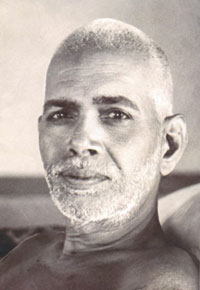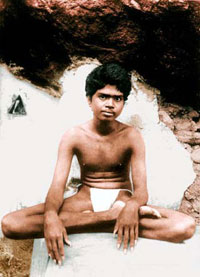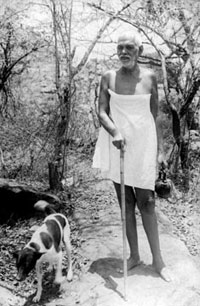Sri Ramana Maharishi Brief Biographical Sketch
and Teachings on Awareness
All that we have to do is to give up identifying the Self with the body, with forms and limits, and then we shall know ourselves as the Self that we always are. — Ramana Maharshi

Rarely one comes across a sight, where the blending of sparkling tranquil awareness the Self and its manifestation in gross physical form can be seen at its purest best. Such an entity is Sage Sri Ramana Maharishi, an embodiment in human form of the pure subtle invisible awareness – Self, who occupies a unique place both in the history of spiritual sages of both India and humanity as a whole.

He was born on 30th December 1879 in Tiruchuzhi a small village thirty miles southeast of the city of Madurai famous for its temples situated in state of Tamil Nadu, in South India . At the age of 12 he lost his father as a result of which he and his elder brother went to live with their paternal uncle in Madurai.
It sometimes happens that one who is on a spiritual path, or even who has not yet begun consciously seeking, has a glimpse of Realisation during which, for a brief eternity, he experiences absolute certainty of his divine, immutable identity of Awareness Self. Such an experience arising out of fear of death came to the Maharshi on 17th July 1896 when he was a lad of sixteen., while sitting alone in a room on the first floor of his uncle’s house, as stated by Sri Ramana in his own words: “The body dies but the Spirit that transcends it cannot be touched by death. That means I am the deathless Spirit.’…… Fear of death had vanished once and for all. Absorption in the Self continued unbroken from that time on” Later when Sri Ramana was relating his experiences in Madurai of the vision of death he said, “In the vision of death, though all the senses were benumbed, the aham sphurana (Self-awareness) was clearly evident, and so I realised that it was that awareness that we call ‘I’, and not the body. This Self-awareness never decays. It is unrelated to anything. It is Self-luminous. Even if this body is burnt, it will not be affected. Hence, I realised on that very day so clearly that that was ‘I’.”

Soon after this change occurred after an arduous journey the great sage made his way to Tiruvannamalai, the town at the foot of the holy hill of Arunachala arriving there on 1st September 1896. He spent the remaining 54 years of his life in the shade of Arunachala. The first half of them was spent in its caves, the last half in an Ashram at the foot of it named Sri Ramanasramam after the great sage.
In order to realise while in the physical body our True identity of Awareness which is the changeless witness of the changing world Sri Ramana has described two methods. The spiritual paths the Maharshi taught were simple and direct. He would often say: “Ask yourself ‘Who am I?’ or submit.” These two paths both lead to the same goal. The one that he offered first was always Self-enquiry. It means concentrating on the pure sense of being, the pure I-am-ness of me. And this, one discovers, is the same as pure consciousness, pure, formless awareness.
Arthur Osborne writes “The power of his presence was overwhelming and his beauty indescribable, and yet, at the same time, he was utterly simple, utterly natural, unassuming, unpretentious, unaffected.” He wrote some small treatises, his main work being Ulladu Narpadu, Forty Verses on That which is, Upadesa Saram, Essence of Instruction and Five hymns on Arunachala, and translated some texts which he considered important and useful for those who were following his advice.
On April 14th, 1950, the maharishi left his physical body. The site made holy by his presence is visited as a place of pilgrimage by spiritual seekers all over the world and the presence of the great sage is always felt there. Many spiritual aspirants have felt his presence there and attained enlightenment, to experience the truth behind these words one has to visit Sri Ramanashramam to experience it firsthand.



